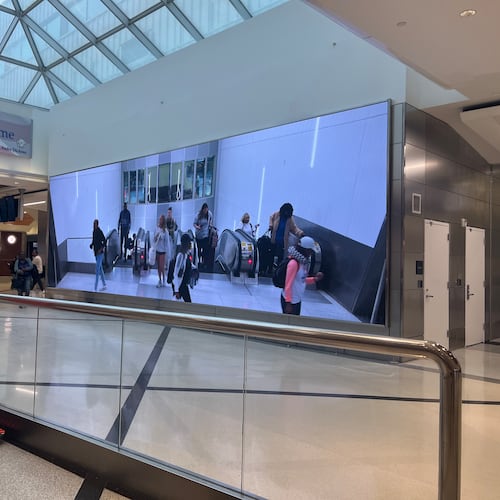For more than three years now, a group of property owners near the airport has been pushing its vision of the future of transportation around Hartsfield-Jackson: small automated vehicles that whisk people throughout the area.
To nurture that idea, the group — ATL Airport Community Improvement Districts — hosted a Podcar City conference on Thursday and Friday, drawing together planners, academics and developers that specialize in autonomous vehicles and podcars.
The organization’s executive director, Gerald McDowell, said he now expects to start a financial feasibility study with MARTA next year, with an eye on soliciting proposals in 2023 from companies that would be interested in developing and building the system.
Credit: Miguel Martinez for The Atlanta Journal-Constitution
Credit: Miguel Martinez for The Atlanta Journal-Constitution
The idea of personal rapid transit is still being studied by the group and MARTA and doesn’t yet have funding. If such a project is launched, it could take nearly a decade to come to fruition.
Earlier this year, the ATL Airport CIDs released a video showing its concept for a personal rapid transit system that moves along guideways in the airport area.
An initial feasibility study suggested a corporate crescent circulator transit line between the domestic terminal and international terminal.
But the vision has since been expanded to include South Fulton and Clayton County, with a larger route network that could draw in residents and workers across a wide swath of the south metro area.
Though Clayton County is home to the world’s busiest airport with 65,000 jobs, it has one of the highest unemployment rates in metro Atlanta, said Clayton County Chairman Jeff Turner during remarks at the conference. He said a big reason for that is a lack of adequate transit for people to get to jobs.
Credit: Miguel Martinez for The Atlanta Journal-Constitution
Credit: Miguel Martinez for The Atlanta Journal-Constitution
McDowell is trying to find funding for the personal rapid transit system. He’s been meeting with elected officials and others to explore the possibility of federal infrastructure money, state funds, county funds or private investment in a public-private partnership — or working with the airport, Atlanta-Region Transit Link Authority or MARTA.
The COVID-19 pandemic, McDowell said, could increase interest in personal rapid transit, as people seek to avoid large crowds on buses or trains.
He said fares would be designed to cover operations and maintenance costs. He estimated fares for transit around the airport would be comparable to MARTA and could be higher in the broader region. The idea would be to cost less than an Uber or Lyft ride, he said.
The system “can be done in ten years or less. That’s our ambition,” McDowell said. “We could be the proving ground.”
About the Author
The Latest
Featured

